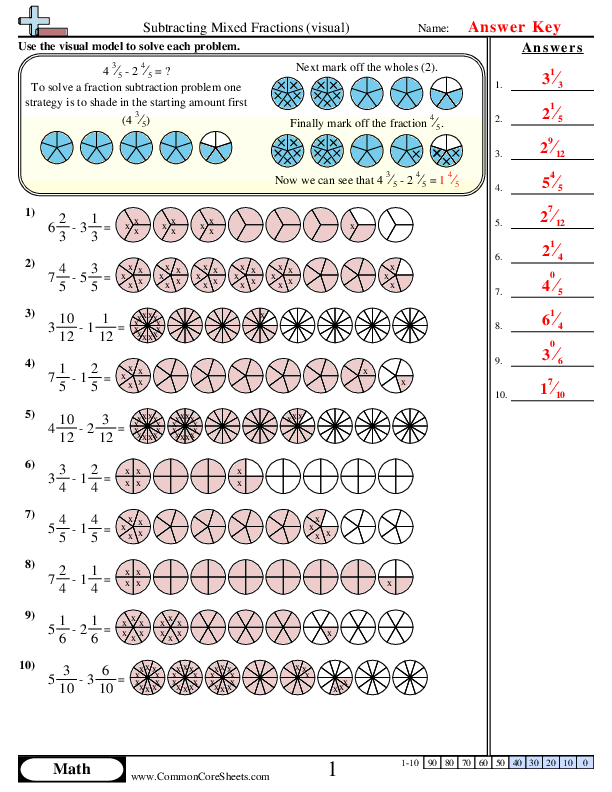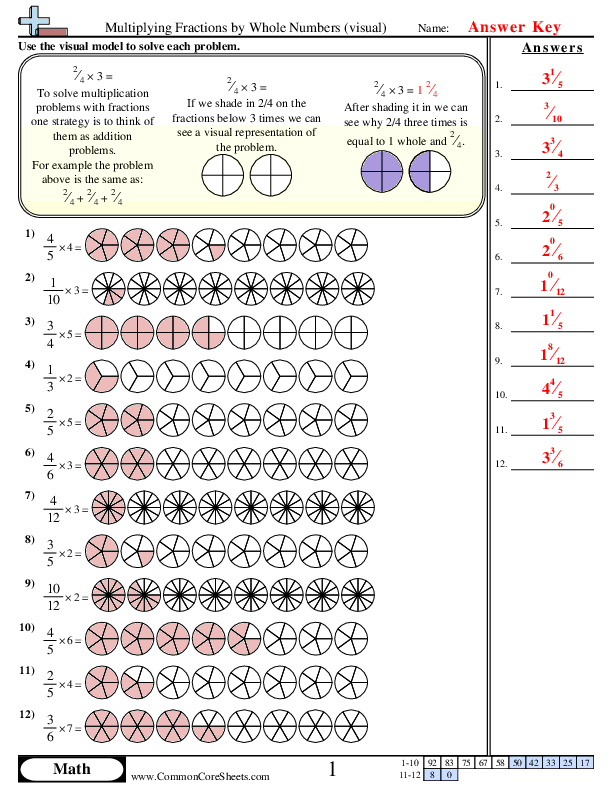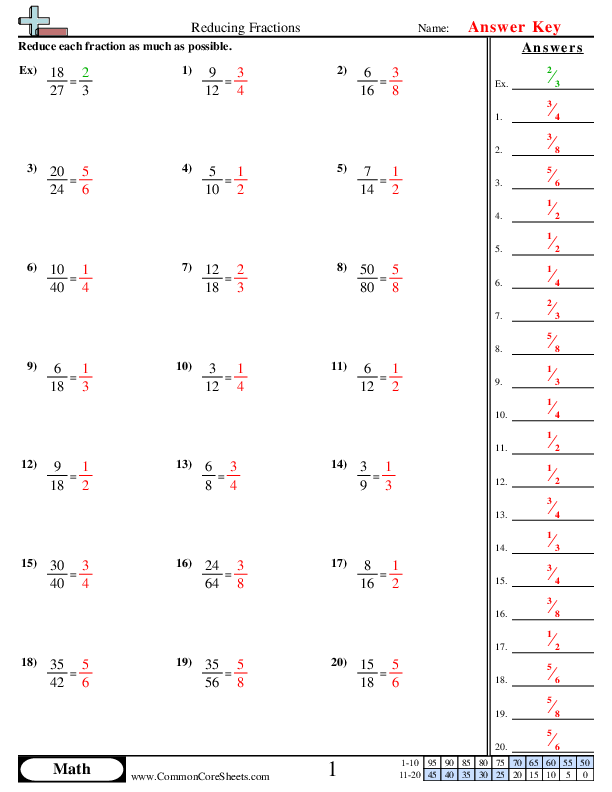Our fraction worksheets are the best on the internet! These free worksheets are perfect for students of all ages who are learning or reviewing fractions. Our fraction worksheets cover a range of skills, from simplifying fractions to adding and subtracting fractions with different denominators. Each worksheet includes clear instructions and plenty of space for students to show their work. With our fraction worksheets, you'll find everything you need to help your students master this important math concept. So why wait? Try our fraction worksheets today and see why they're the best on the internet!
Browse Sheets By Problem Type
×
Adding & Subtracting Fractions
Link
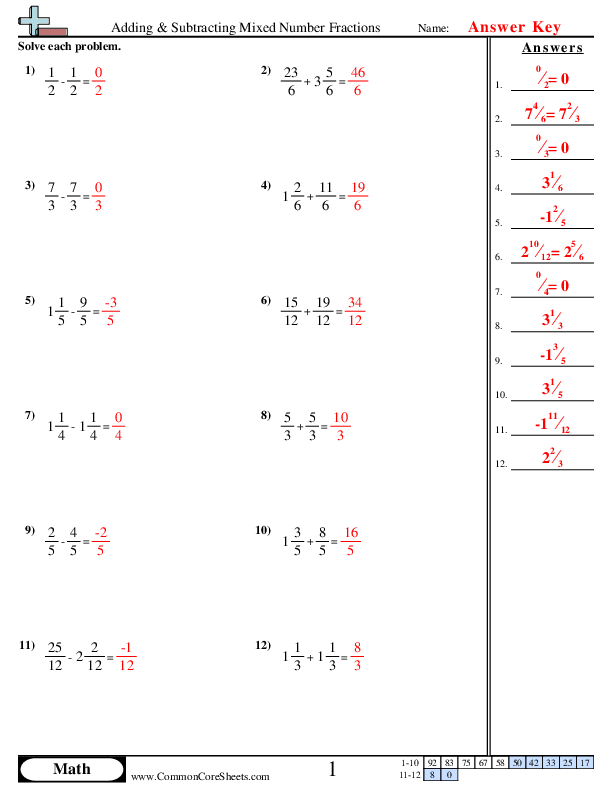
Mixed Fractions (Same Denominator)
4nf3c


×
Description:
"This worksheet is designed to help children master the concept of adding and subtracting mixed number fractions. It includes 12 interactive problems arranged in a clear and friendly layout to improve problem-solving skills. With options for customization, this mathematics worksheet can be easily converted into flash cards and is ideally suited for distance learning environments. A perfect tool for fostering a love for numbers in young learners."

×
Student Goals:
Understanding Mixed Numbers and FractionsBy completing this worksheet successfully, students should be able to demonstrate their understanding of both mixed numbers and fractions. This involves being able to convert between the two, as well as performing basic arithmetic operations on them. This is an important concept in mathematics as it enhances numerical skills and allows students to better understand mathematical operations from a complex contextual viewpoint.Performing Addition and Subtraction on Mixed FractionsStudents should be able to confidently and correctly perform addition and subtraction operations on mixed fraction numbers. Mastering these key operational skills within fractions and mixed numbers, it will lay a strong foundation for understanding more complex mathematical operations and concepts later on. This corresponds broadly to their ability to manipulate and work with numerical values within a certain mathematical structure.Improving Problem-Solving SkillsSolving problems in math often requires students to think critically and strategically. The successful completion of this worksheet should imply that students have improved their problem-solving skills. They should also be able to apply different approaches to solve the presented problems which is an important skill in learning and life.Developing Mathematical FluencyFollowing completion of this worksheet, students should have developed improved mathematical fluency particularly in regard to working with fractions and mixed numbers. Their capacity and speed to perform addition and subtraction operations on mixed fractions should be enhanced, making similar future tasks easier and quicker to solve.Enhancing Math ConfidenceLastly, successfully completing this worksheet should be a confidence booster for the students. It provides them with the opportunity to test their understanding, solve complex problems, and consequently gain the much-needed trust in their mathematical abilities. This will further encourage them to engage more freely with such tasks and math in general, thereby, contributing positively to their overall mathematical proficiency.



Improper Fractions (Same Denominator)
4nf3c


×
Description:
"This worksheet is designed to help children comprehend addition and subtraction of improper fractions. Covering a set of 12 problem-based scenarios, the worksheet tackles the concept extensively. It can be customized according to the learner's speed, converted into flashcards for easy understanding, and is perfect for distance learning. With clearly designed problems and their solutions, it serves as a crucial tool for mastering improper fractions."

×
Student Goals:
Understanding of FractionsStudents will acquire a firm understanding of the concept of improper fractions. They will be able to accurately define an improper fraction and distinguish it from a proper fraction. This comprehension will lay the foundation for more advanced mathematical concepts, promoting the students' academic development in the subject.Fractions Arithmetic SkillsBy completing the problems in the worksheet, students will significantly enhance their arithmetic skills with improper fractions. They will be fluent in both adding and subtracting improper fractions, a fundamental aspect of arithmetic operations involving fractions. This proficiency in calculation can potentially aid students in solving complex real-world problems.Critical and Analytical ThinkingWorking through the worksheet will promote students' critical and analytical thinking abilities. They will learn to approach each problem logically and systematically, mapping out their workings step by step. This way, they will actively engage in each task instead of merely calculating, fostering critical thinking skills that extend beyond math into other fields of study.Accuracy and PrecisionThrough practice, students will develop skills in accuracy and precision. They will learn to pay close attention to detail while handling fractions, ensuring that elements such as the numerator, denominator, and mathematical operations are correctly identified and processed. This attention to detail and precision are essential in the study of mathematics and other technical subjects.Confidence BuildingThe successful completion of the worksheet will instill a sense of accomplishment and confidence in the students. Overcoming mathematical challenges can empower students, making them more eager and less intimidated by complex mathematical tasks in future studies. This mental preparedness and self-assuredness can play a significant role in their overall academic success and interest in learning.Application in Real World ScenariosFinally, this worksheet will enable the students to apply the skills learned to real-world scenarios. Understanding the addition and subtraction of improper fractions can be practically applied in various areas including baking, carpentry, finance, and many more. This transfer of knowledge from theoretical to practical makes their learning more worthwhile and meaningful.



Subtracting Fractions (with regrouping)
4nf3c


×
Description:
"This worksheet is designed to enhance children's understanding of subtracting fractions with regrouping in math. With 14 comprehensive problems, the content reinforces the concept in a practical, engaging manner. The worksheet can be customized to cater to each child's learning pace, enabling its conversion into flashcards or incorporation into distance learning programs for a versatile educational experience."

×
Student Goals:
Understanding Fraction SubtractionBy completing this worksheet, students should develop a strong understanding of subtraction of fractions, especially those requiring regrouping. They should feel confident tackling similar problems independently. Mastering this essential mathematical concept is vital, as it is a foundational skill that serves as a building block for more complex concepts.Acquiring Problem-Solving SkillsIn performing these subtraction tasks, children will bolster key problem-solving skills. They will be able to identify the variables within the problem, apply the correct mathematical operation (in this case, subtraction), and come to an accurate solution. This development of problem-solving abilities will be applicable not only in their ongoing mathematical education but across their general learning.Fostering Mathematical ReasoningAs students work through these fraction subtraction problems, they should be encouraged to explain their reasoning. This practice in mathematical reasoning helps them recognize the logic behind the operations and reinforces their understanding. It also allows them to communicate mathematical concepts effectively, a critical skill for their ongoing education.Improving Accuracy and PrecisionBy consistently practicing subtraction of fractions with these exercises, students will improve their precision and accuracy in carrying out the operations. They will get better at keeping track of the denominator and handling the regrouping process where necessary. As they hone these finely detailed skills, they will be better suited to tackling more advanced mathematical concepts in future.Building Confidence in MathematicsAs students experience success in completing these fraction subtraction problems, they are likely to build their self-confidence in mathematics. With increased confidence, students are more likely to actively engage in math lessons and take on more challenging problems. This cultivated self-assuredness in their mathematical abilities can foster a positive attitude towards the subject.


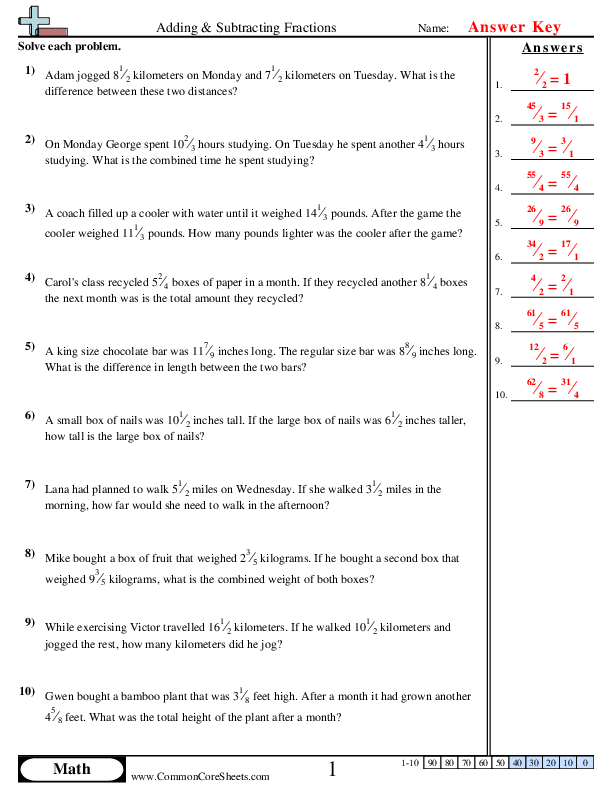
Word Problems Same Denominator
4nf3d


×
Description:
"This worksheet is designed to enhance students' understanding of adding and subtracting fractions in real-life scenarios. A total of 10 diverse math problems cover topics from candy quantity to plant growth and studying hours. Customizable and adaptable, the worksheet can be transformed into interactive flashcards. It's compatible with distance learning platforms, fostering remote, yet effective learning."

×
Student Goals:
Understanding Fractional ConceptsAfter completing the worksheet, students should have a solid foundation in understanding fractional concepts. They should be able to interpret fractions in the context of authentic everyday situations, realizing that fractions are not just abstract numbers but relate to real-world quantities and measurements.Addition and Subtraction of FractionsStudents should accomplish mastery in the key skill of adding and subtracting fractions. This includes fractions with same or different denominators and they should be comfortable in applying the addition/subtraction rules to solve the problems.Problem SolvingBy working through the worksheet, students should refine their problem-solving skills, particularly in navigating word problems. They should become adept at decoding the problem, extracting the important information, and forming an appropriate strategy to reach a solution.Mathematical ReasoningStudents should improve in understanding mathematical reasoning and logic. They should be able to show clear reasoning about why the procedures for adding or subtracting fractions make sense and work for the situations.Real-World ApplicationChildren should gain confidence in applying their mathematical skills and knowledge to real-world contexts. The worksheet problems introduce them to a variety of practical situations where fractions are used, furthering their ability to see the relevance and application of fractions in everyday life.Interlinking of Mathematical TopicsCompiling fraction addition and subtraction along with other mathematical topics (like distance, weight, time). Students would have linked these various math topics by the end of this worksheet, which is crucial for their ability to fluidly navigate more complex mathematical problems in the future.


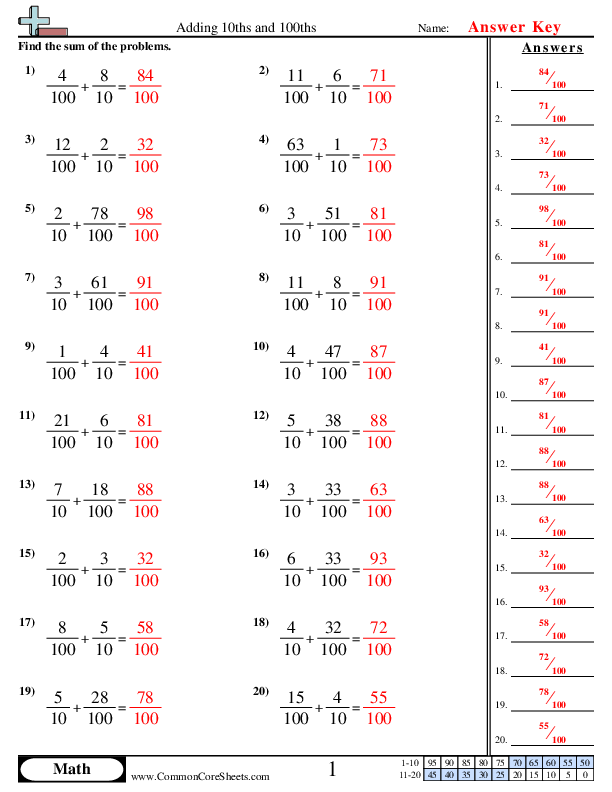
Adding 10ths and 100ths
4nf5


×
Description:
"This worksheet is designed to enhance students' understanding of adding fractions with tenths and hundredths. Featuring 20 math problems, the interactive module allows for comprehensive practice and concept reinforcement. It can be customized to suit an individual's learning pace, adapted into flashcards for quick review sessions, and is perfect for distance learning. An invaluable tool, the worksheet helps students master an essential mathematical concept."

×
Student Goals:
Mastering Mathematical ConceptsAfter completing this worksheet, students will have honed their understanding of the decimal system, particularly focusing on tenths and hundredths. They should be able to accurately perform addition operations involving numbers in decimal form. This involves correctly recognizing and placing value on the decimal point, an essential skill in mathematical computations.Developing Problem Solving SkillsThrough this engaging activity, students will have enhanced their problem-solving skills and basic strategic thinking. They will understand how to approach and solve mathematical problems systematically. These skills don't only apply to math problems, but to tasks and objectives in everyday life, helping students to become more effective thinkers.Boosting Accuracy and SpeedWith repeated completion of this worksheet, students will become more accurate and quick in carrying out operations involving tenths and hundredths. This improvement in speed and precision is critical for upcoming challenges, such as timed tests, and more complex calculations.Enhancing Numeracy SkillsThe completion of the worksheet will help improve the student's numeracy skills, fostering flexibility and fluency in handling numbers. This ability is fundamental in various fields involving complex calculations such as engineering, physics, and even computer science.Increasing Confidence in Mathematical AbilitiesFollowing successful completion and understanding of the concepts found in this worksheet, students should feel more confident in their mathematical abilities. This sense of achievement can motivate them to tackle more challenging math problems, encouraging a positive attitude towards the subject.Preparation for More Complex TopicsThis worksheet provides a solid foundation for more complex math topics in the future. Understanding the basics of adding tenths and hundredths is crucial for subjects like algebra and geometry. Therefore, this accomplishment will make future learning smoother and more effective.



Adding Parts of a Whole
4nf3b


×
Description:
"This worksheet is designed to enhance children's understanding of fractions using a visual approach focusing on adding parts of a whole. With a set of 15 distinct problems, children are encouraged to identify the sum of fractions depicted as filled sections of different diagrams. Ideal for distance learning, these math material can be customized based on learning level and can be converted into handy flash cards for interactive and engaging learning."

×
Student Goals:
Understanding of Mathematical ConceptsStudents will achieve a deeper understanding of the concept of fractions and their role as parts of a whole. They will learn that fractions are used to represent parts of a whole and that adding fractions gives you the sum that still part of the same whole.Enhanced Calculation SkillsBy solving fraction problems, students will better their calculation skills. They'll become proficient at adding fractions, which will establish a strong foundation for more complex arithmetic operations, and they will witness the versatility of mathematics in real-life situations.Ability to Solve Problems IndependentlyWith enough practice from the worksheet, students will be equipped with problem-solving skills. They'll be able to solve similar problems and work through different mathematical challenges on their own. The worksheet encourages independent thought, which is a crucial skill in the learning process.Confidence in Handling FractionsEfficiently understanding and being able to perform fraction additions will foster students' confidence in handling fractions. This accomplishment will reduce any anxiety or hesitation that students may associate with fractions or mathematics in general, and prepare them for dealing with more complex fraction problems in the future.Concept of Equivalent FractionsDuring the course of this exercise, students will discover equivalent fractions. Adding same fractions will bring out instances where the result could be written as a whole number or other fractions, thereby introducing them to the concept of equivalent fractions.Understanding the Concept of SimplificationStudents will learn the process of simplification by adding parts of a whole. When certain fractions are added and they yield a result which could be reduced to a simpler form, students are indirectly learning the concept of simplifying fractions. This is an important mathematical skill which will help them in dealing with more complicated fraction operations.


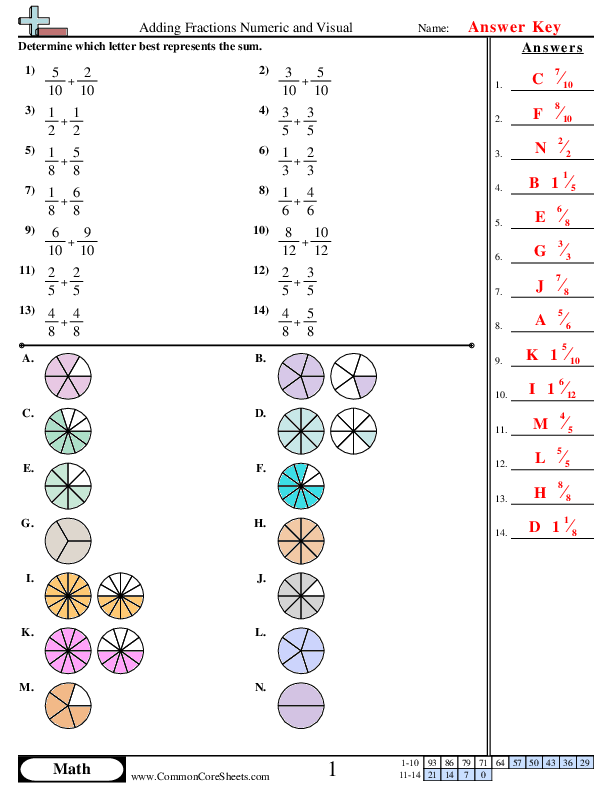
Adding Fractions Numeric & Visual
4nf3c


×
Description:
"This worksheet is designed to reinforce children's understanding of adding fractions through a mix of numeric and visual methods. It contains 14 math problems with various examples, emphasizing on fundamental concepts in a fun and engaging manner. The worksheet's versatility allows customization based on student needs, can be converted into flashcards for continuous practice, and supports distance learning. It is a perfect tool to expand children's problem-solving skills and their comprehension of fraction addition."

×
Student Goals:
Understanding Fraction AdditionThrough completing the worksheet, students should be able to effortlessly comprehend the concept of fraction addition. They should be apt at recognizing the similarities of fractions, aligning fractions with common denominators and proficiently summing them up.Developing Numerical SkillsSolving these problems on the worksheet reinforces the students' ability to manipulate and work with numbers. The students should be able to quickly add fractions, making them faster with their mental arithmetic and improving their general math capabilities.Improving Problem-Solving SkillsEach math problem a child solves develops their problem-solving skills. This worksheet offers a variety of problems that focus on fraction addition. By the end, students should be able to apply what they've learned to solve new problems and situations.Mastering Visual RepresentationsAfter completing the worksheet, students should be adept at visualizing fractions as parts of a whole, which is crucial for their understanding of more complex mathematical concepts in the future. They should also be able to associate numerically expressed fractions with their visual representations.Overcoming Math AnxietyMath can sometimes provoke anxiety among students. However, the repetitive exercises in this worksheet, coupled with their gradual increase in complexity, should allow students to gain confidence in their ability to handle numbers and fractions, thereby reducing any nervousness associated with math.Gaining Proficiency in Math LanguageA competency that students should achieve after completing this worksheet is the fluency in the language of mathematics. They should have bolstered their knowledge of the terms and symbols associated with fractions and improved their ability to read, write and interpret mathematical statements.Enhancing Focus and AttentionWorking through math problems requires a certain level of concentration and attention to detail. Completion of this worksheet should have given students the chance to work on their ability to concentrate, conceptualize problems and follow through until they arrive at a correct solution.


Multiplying & Dividing Fractions
Link
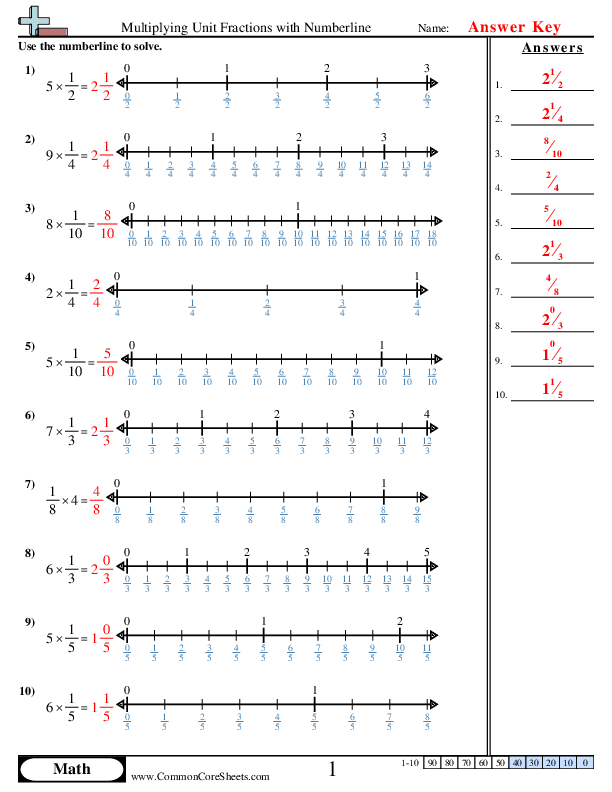
Multiplying Unit Fractions with Numberlines
4nf4a


×
Description:
"This worksheet is designed to reinforce children's understanding and skills in multiplying unit fractions using a number line. It includes 10 customizable math problems that illustrate the concept advantageously. The adaptable structure of the material also allows it to be converted into flashcards, aiding versatile and dynamic learning suitable for both conventional and distance learning setups. A great tool to build foundational math skills in an engaging way."

×
Student Goals:
Problem Solving SkillsAfter completion of the worksheet, learners will have increased their problem-solving skills. They will be able to handle a range of math problems, specially related to unit fractions and multiplying them efficiently. Their mental math skills will be developed as well as a deeper appreciation for the step-by-step process in computation.Knowledge of Number LinesBefore the worksheet, children might have only a basic understanding of number lines and how to use them for adding or subtracting numbers. After practicing with this worksheet, they would have a strong grasp of their application for multiplying unit fractions. They will understand the link between fractions and points on the number line, as well as its representation of their multiplication results. This is a profound learning that is essential for further studies in mathematics.Understanding Unit FractionsUnit fractions are the building blocks of other fractions and essential for developing strong fraction concepts. After completing the worksheet, students will have a concrete understanding of unit fractions and their multiplication. They will know how unit fractions compose other fractions and how changing the numerator influences the fraction's value. This knowledge can be generalized to other math areas, such as algebraic fractions.Mathematical ConfidenceMathematics can be a daunting subject for many students. By working through problems on their own, students will build confidence in their own abilities. This worksheet provides the necessary practice for students to solidify knowledge and boost their confidence. The more they practice, the less intimidating the subject becomes. They will feel more comfortable tackling similar problems in their coursework or exams and will exhibit increased enthusiasm and interest in mathematics.Critical Thinking and ReasoningAfter diligently finishing the worksheet, scholars are expected to have sharpened their critical thinking skills. They will be accustomed to thinking logically, breaking down problems, making calculations, and arriving at conclusions. This capacity to make logical connections and reason mathematically is not only useful in math studies but across all academic disciplines.Preparation for Advanced TopicsMultiplying unit fractions is a seminal concept in mathematics, and understanding it is crucial for grasping more advanced topics in the field. Mastery of this skill will prepare students for a smoother transition to more complex mathematical problems, such as those involving whole numbers, mixed numbers, decimal numbers, ratios, and proportions. The ability to multiply unit fractions efficiently provides learners with a solid base for more advanced mathematical exploration.


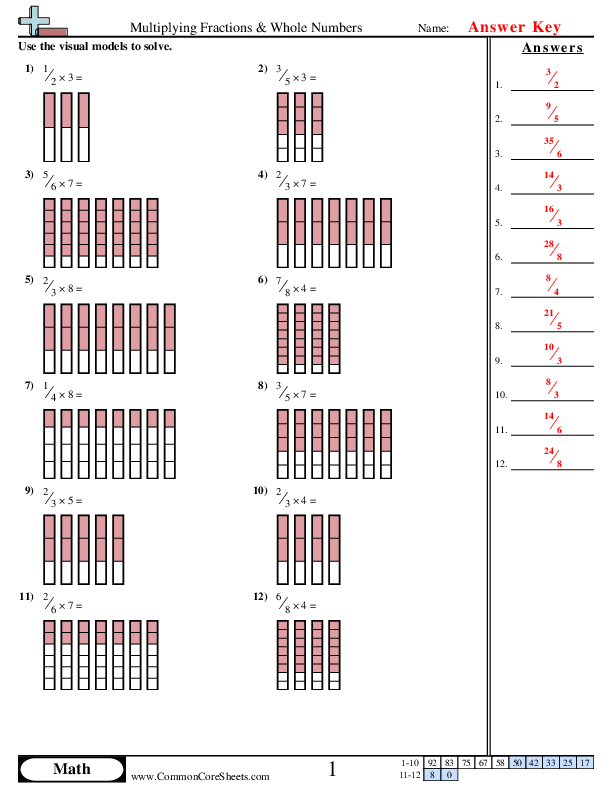
Multiplying Fractions & Whole Numbers
4nf4b


×
Description:
"This worksheet is designed to help children understand the concept of multiplying fractions with whole numbers. It contains 12 math problems, providing sufficient practice in this key area. The worksheet can be easily customized, turned into flash cards for hands-on learning, or even used for distance education programs, making it adaptable for various teaching methods and learning preferences."

×
Student Goals:
Mastery of Fraction and Whole Number MultiplicationUpon completion of this worksheet, students should have a solid understanding of how to multiply fractions by whole numbers—a key skill in the subject of mathematics. This understanding will allow them to solve a wide range of real-world and abstract mathematical problems, increasing their overall mathematical literacy and competency.Procedural ProficiencyStudents should be able to fluently and correctly follow the process of multiplying fractions by whole numbers. They should know how to simplify fractions where necessary, convert whole numbers to fractions, and carry out multiplication, then represent their answers in the simplest form. This demonstrates their procedural proficiency, an essential part of computational mathematics.Problem-Solving AbilityWith the successful completion of this worksheet, students should be able to apply their fraction and whole number multiplication skills in various contexts. This helps in enhancing their mathematical problem-solving capability. They should be capable of interpreting problems, devising a plan to solve them, and executing that plan to obtain the correct answer.Mathematical ConfidenceBy completing the worksheet, students will have had the opportunity to build confidence in their mathematical abilities. Successfully solving these problems will give them the assurance that they have grasped a fundamental math concept. This growing confidence is vital in encouraging them to tackle more complex mathematics down the line.Application of Maths ConceptsThe multiplication of fractions and whole numbers is not just a stand-alone lesson—it’s part of larger mathematical concepts. After completing this worksheet, students should be able to apply this skill in other areas of math such as algebra, real-world application problems, and more. Understanding this connection to broader mathematical concepts further deepens their understanding of the subject.Preparedness for Advanced MathsThis worksheet lays important groundwork for more advanced mathematical concepts that students will encounter in later years of schooling. The mastery of fraction multiplication is crucial as they progress to more complex mathematical operations such as division of fractions, algebraic fractions, or even when delving into calculus. Success with this worksheet thus creates a strong foundation for future success in mathematics.


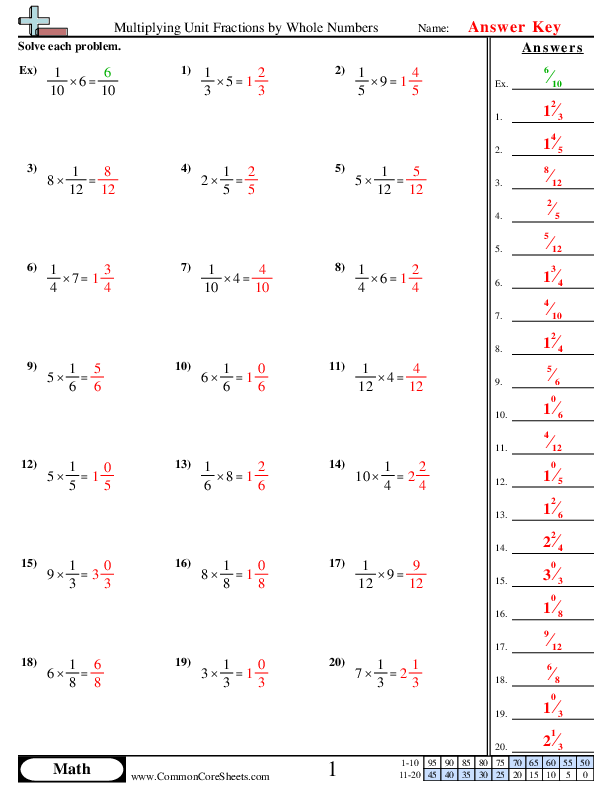
Multiplying Unit Fractions by Whole Numbers
4nf4a


×
Description:
"This worksheet is designed to help children practice multiplying unit fractions by whole numbers. An essential math concept, this worksheet features 20 comprehensive problems ranging from simple to complex. Perfect for personalized learning, it can be easily customized to match a child's pace of learning, converted into interactive flashcards or incorporated into a distance learning curriculum to facilitate better understanding."

×
Student Goals:
Understanding of Multiplication ConceptAfter completing the worksheet, students can demonstrate an improved understanding of multiplication as a concept, particularly regarding the multiplication of unit fractions by whole numbers. They gain clarity on how multiplication is used to calculate the product of a whole number multiplied by a fraction.Mathematical Skills EnhancementStudents can enhance their mathematical skills with diligent practice. The worksheet equips students with the ability to perform efficient and accurate calculations involving fractions and whole numbers, reinforcing their basic math competency and the application of theoretical arithmetic concepts.Critical ThinkingBy navigating through diverse multiplication problems, students inherently improve their logical reasoning and critical thinking skills. The mathematical challenges presented in the worksheet compel them to deduce, strategise, and problem-solve, therefore, fostering significant cognitive development.Grasp of Fractional ValuesThe comprehensive practice provided by the worksheet aids students in better understanding fractional values and how they operate within multiplication. They also develop a strong familiarity with unit fractions, enabling them to work with such values confidently in more complex mathematical contexts.Operational Fluency in MultiplicationAfter completing the worksheet, students are expected to show increased fluency in multiplication operations. They will grow adept in calculating the product of unit fractions by whole numbers with precision and speed, demonstrating increased proficiency in the application of multiplication within mathematical settings.Awareness of Numerical RelationshipsBy working with unit fractions and whole numbers, students grasp the relationship between these sets of numbers. The worksheet encourages them to explore and understand the dynamics between fractions and whole numbers, enlightening them about the fundamentals of number theory.Mathematical ConfidenceFinally, working through and completing the worksheet imparts a developed sense of confidence in students concerning their mathematical abilities. By overcoming the challenges presented in a worksheet, students enhance not only their mathematical skills but also their academic morale, perseverance, and self-efficiency.


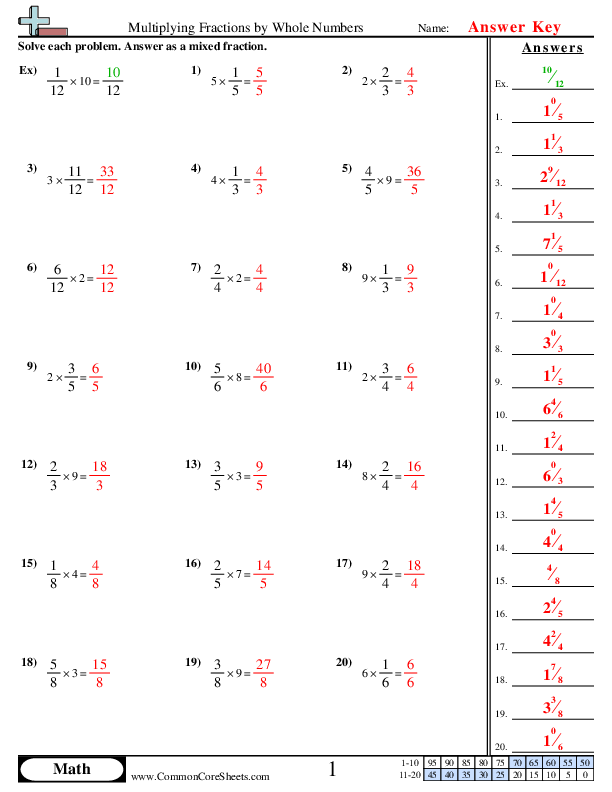
Multiplying Fractions by Whole Numbers
4nf4a


×
Description:
"This worksheet is designed to reinforce children's understanding of multiplying fractions by whole numbers. Through 20 carefully crafted math problems, students will grasp this essential concept in mathematics. The versatility of this worksheet allows it to be customized to fit individual learning styles, converted into interactive flashcards for engaging study, or implemented in distance learning curriculum to ensure continued academic growth no matter the setting."

×
Student Goals:
Understanding FractionsUpon completing the worksheet, students should have a strong understanding of fractions. They should comprehend the fundamental aspects of fractions, including numerators and denominators, and how they affect the value of the fraction. By working through the problems, they will also understand the relationship between fractions and whole numbers. From this, students should be able to confidently interpret and translate real-world situations that involve fractions.Multiplication SkillsThis worksheet will help students hone their multiplication skills, not only when it comes to multiplying whole numbers amongst themselves, but also in multiplication between whole numbers and fractions. Students should be comfortable multiplying fractions and whole numbers together in different combinations and understand how to simplify the resultant fractions as required.Problem-Solving AbilitiesStudents should be able to develop problem-solving skills as they push through each problem, choosing the correct formula to apply when dealing with fractions and whole numbers. The exercise should foster their ability to think critically, helping them identify patterns or shortcuts that can aid in rapidly solving multiplication problems involving whole numbers and fractions.Confidence in MathematicsThe worksheet assists in building students' confidence and interest in mathematics. After completion, students should feel accomplished and have a new-found, or reinforced, confidence to tackle similar fraction problems, thus molding a positive and courageous attitude towards maths as a whole. It catalyzes their engagement with more complex problems in the future.Practical ApplicationBy mastering the multiplication of fractions by whole numbers, students should be equipped to handle real-life applications of fractions. This includes understanding and interpreting situations that involve division of quantities into fractional parts.


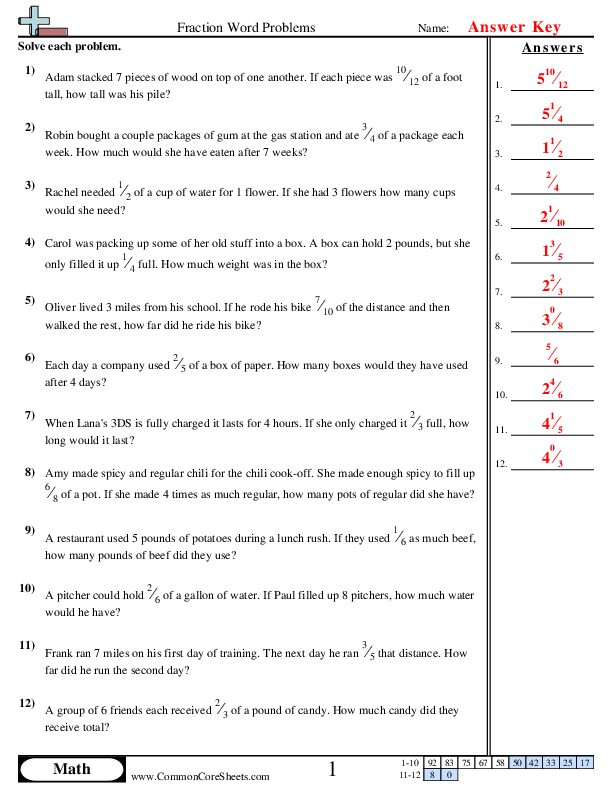
Multiplying Fraction by a whole (word)
4nf4c


×
Description:
"This worksheet is designed to help children practice and learn math, particularly fractions, through real-world problems. Key topics include multiplication and division of fractions, understanding of proportions, and practical applications of fractions. With 12 customizable problems, it offers flexibility to adapt according to learning needs. The worksheet can be converted into flash cards or used for distance learning, fostering a more interactive and engaging learning experience."

×
Student Goals:
Understanding FractionsUpon completion of this worksheet, students will be able to demonstrate a sound understanding of fractions. They will understand how fractions are used in everyday situations and can apply their knowledge to solve various problems. They will understand the concept that fractions represent parts of a whole, and be able to apply this in the context of real life scenarios.Problem-Solving SkillsThis worksheet encourages students to develop and apply problem-solving skills. They will approach each fraction-based word problem critically and strategically, refining their analytical thinking process. Students will be more skilled at translating real life situations into mathematical expressions, breaking down problems, and methodically working their way to solutions.Multiplication and Division of FractionsStudents will further enhance their arithmetic skills specifically on multiplication and division of fractions. They will practice these operations within a diverse range of problems, assisting them in mastering the mathematical principles involved when multiplying or dividing fractions.Application of Math in the Real WorldThrough solving word problems featuring real world scenarios, students will learn to apply math to their everyday lives. They will understand how fractions fit into diverse situations, from baking cakes to measuring distances. This will stimulate an appreciation of how math is deeply entrenched in practical uses, thereby adding relevance to the subject matter.Increased Confidence and Proficiency in MathBy successfully completing this worksheet, students will foster a sense of achievement which will contribute to their overall math confidence and proficiency. They will gain the solid groundwork and reinforcement needed to tackle more complex mathematical problems. Additionally, their enhanced abilities in solving fraction-related problems will provide them the readiness for more advanced mathematical topics.


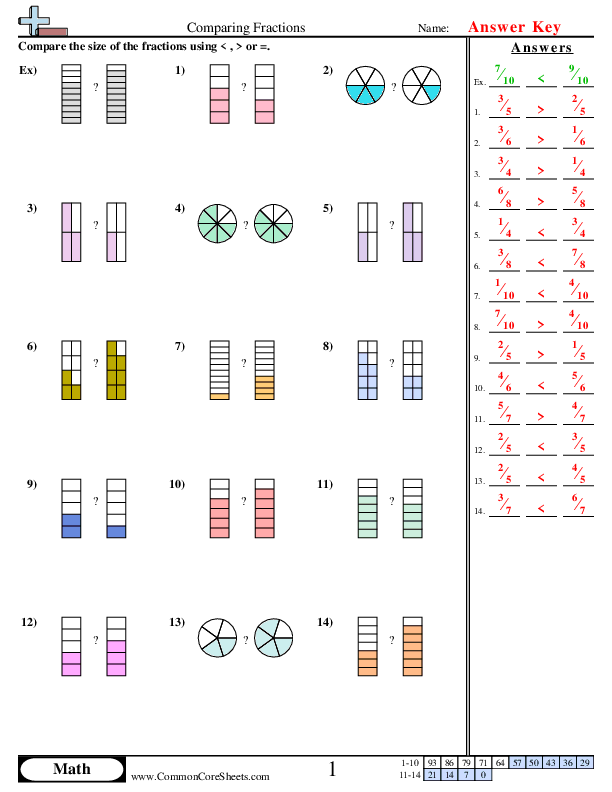
Comparing Fractions


×
Description:
"This worksheet is designed to enhance children's understanding of comparing fractions through engaging and visually appealing math exercises. It features 14 unique problems, utilizing dynamic graphics to aid comprehension. The customizable content can be transformed into flashcards to facilitate seamless learning, making it an excellent resource for distance learning programs. It offers a fun, interactive way to learn an essential math skill."

×
Student Goals:
Understanding FractionsAfter completing the Comparing Fractions worksheet, students should have a solid conceptual understanding of fractions. They should be able to recognize and identify fractions in various formats and understand what these fractions represent.Comparing FractionsStudents should be able to accurately compare fractions. They should have gained an understanding of how to determine which of two fractions is greater or smaller, and they should be able to order fractions from least to greatest or vice versa. They should also be familiar with the concept of equivalent fractions.Problem Solving SkillsThe worksheet should improve students' math problem-solving skills. Students will be able to approach problems related to fractions methodically, deploying suitable strategies for their resolution. They will know how to break down complex problems into manageable parts.Application of LearningsAfter working through the worksheet, students should be able to transfer their knowledge about fractions into solving real-world problems. They should be able to perceive the relevance of fractions in daily life situations like cooking, shopping, and time and distance calculations.Independence in LearningThe worksheet is envisaged to enhance students' ability to learn independently. It should encourage students to explore the different methods of comparing fractions for themselves, to understand the pitfalls and advantages of each method, and to select the most suitable method for a given problem.Building ConfidenceCompletion of this worksheet should also build confidence in students. As they improve their ability to compare fractions correctly, they will gain confidence in their math skills. This increased confidence and familiarity with fractions can comfort them when dealing with more complex mathematical problems in future.


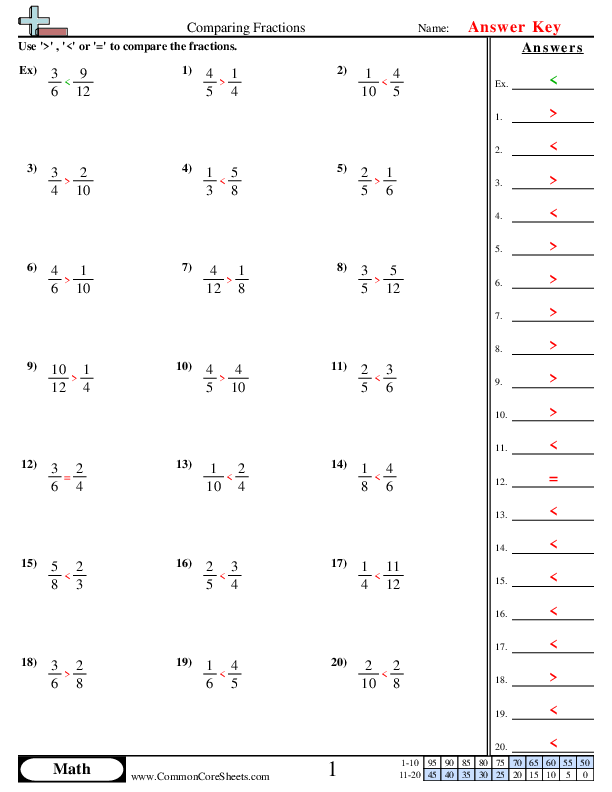
Comparing Numerically (Different Denominator)
4nf2


×
Description:
"This worksheet is designed to strengthen children's understanding of comparing fractions in math. It contains 20 distinct problems, where children will decide if one fraction is greater than, less than, or equal to another. Dynamic and engaging, this material can be customized based on learner's needs. It also has the capacity to be converted into flashcards for a more visual approach and is adaptable for distance learning, maximizing instruction during remote education sessions."

×
Student Goals:
Understanding of FractionsUpon completion of the worksheet, students should have an improved understanding of fractions. They should be able to identify the numerator as the number that represents a part of the whole and the denominator as the total number of parts in that whole. Recognizing these aspects of fractions is fundamental to further mathematical learning.Comparing FractionsStudents should have mastered how to compare fractions effectively. They should be able to determine if a fraction is less than, equal to, or greater than another and justify their reasoning. The comparison of fractions is a fundamental skill that students will utilize in various aspects of their lives, from simple daily activities to complex problem solving in future mathematics studies.Proportional ReasoningThis worksheet should provide students with a clear understanding of proportional reasoning concepts. Through comparing fractions, students should begin to grasp the reciprocal relationship between the numbers in a fraction and the principled way in which they interact. This essential comprehension will assist them in solving more sophisticated mathematical problems down the line.Augmented Problem-Solving AbilitiesBy completing this worksheet, students should significantly improve their problem-solving abilities. They will enhance not only their critical thinking skills but also their ability to apply mathematical principles to solve problems systematically. This improvement will definitely provide a solid foundation for more complex mathematical tasks that they will encounter through their educational journey.Familiarity with Fractional NotationHaving worked with a variety of fractions on this worksheet, students should develop a familiarity with fractional notation. They should understand the differences between proper and improper fractions and be able to recognize equivalent fractions. This understanding of fractional notation will greatly assist them when they progress to additional math subjects such as algebra and calculus.Build ConfidenceCompletion of the worksheet should instill a sense of mathematical confidence in the students. Familiarity and understanding of the topic should reduce math anxiety and encourage students to take on more challenging mathematical concepts. Handling complex problems with ease will boost their confidence and enhance their overall academic performance.



Less, More or Equal to half (Evenly divisible)
4nf2


×
Description:
"This worksheet is designed to educate children on the concept of fractions relative to half in a math context. It encompasses 20 distinctive problems, ranging from basics such as 3/6 to more challenging instances like 5/8. Perfect for distance learning, the worksheet is flexible, allowing for user customization and a seamless conversion into flashcards to enhance comprehension and memory retention. Ideal for instilling a strong foundation in fractions."

×
Student Goals:
Understanding of FractionsAfter completing the worksheet, students should have a deeper understanding of fractions. They should be able to identify numerators and denominators and what they represent in the context of a whole. They should understand how fractions are used to represent portions of a whole, and how different fractions can express the same value.Conversion SkillsStudents should be able to convert fractions to their simplest form. For example, they should know that 2/4 is the same as 1/2. They should also be able to convert improper fractions to mixed numbers, and vice versa. Their ability to compare and order fractions should also be enhanced.Relating Fractions to HalfAn important learning outcome is for students to understand fractions relative to the value of one half. They should appreciate how different fractions are smaller or larger than one half. They should be able to make estimations about the value of fractions based on their relation to one half.Problem Solving SkillsCompletion of the worksheet should also bolster students' problem-solving skills. Not only will students answer specific problems, but they will also apply concepts and strategies learned to solve new, unfamiliar fractional problems. This applies their understanding in a practical and meaningful way.Math Language and TermsThe worksheet should arm students with the correct mathematical language and terms. They should be able to use the proper terminology and symbols when representing and discussing fractions. This helps them to effectively communicate their mathematical thoughts and understandings.Confidence in MathematicsLastly, successfully working out fraction problems can boost students' confidence in their math abilities. They should feel encouraged to further explore and learn more complex fraction concepts and other areas of mathematics. Overall, the enhanced confidence could foster a positive attitude towards learning mathematics.



Comparing Fractions with Addition & Subtraction
4nf3d


×
Description:
"This worksheet is designed to strengthen children's grasp on comparing fractions. Through a series of 15 math problems, kids will exercise their skills in recognizing larger, smaller, or equal fractions. In a fun, interactive format, they'll also practice addition and subtraction using fractions. The worksheet is fully customizable, making it a versatile tool for in-person or distance learning. There's also an option to convert the problems into flashcards, enhancing the learning process."

×
Student Goals:
Understanding of FractionsAfter completing the worksheet, students should have developed a stronger understanding of fractions. They should have a grasp of the concept that a fraction represents a part of a whole and be able to identify the numerator and the denominator. They should understand what these parts signify, with the numerator indicating the number of selected parts and the denominator reflecting the total number of equal parts in a whole. The worksheet should make students comfortable in navigating the fundamental notion of fractions.Ability to Compare FractionsThe worksheet aims to strengthen the student's ability to evaluate and compare fractions. By solving the problems, students should understand how to discern whether a fraction is larger or smaller than another, recognizing the role of the numerator and the denominator in this process. Comparative signs in the problems should enforce this understanding. It is expected that students will develop their comparative skills with fractions via this worksheet.Fraction Addition and SubtractionA key accomplishment of completing the worksheet is the ability to add and subtract fractions. It should assist students in understanding the procedures of the addition and subtraction operations on fractions. They should be able to accurately add or subtract fractions with the same denominator, a keystone in fraction arithmetic.Problem-Solving SkillsThe worksheet is designed to equip the students with the crucial skill of problem-solving. By working through the problems, students should not only employ their knowledge of fractions but also their logical and analytical abilities. They should be proficient in understanding the problem’s requirements, devising a plan to solve the problem, successfully executing the plan and finally, reviewing the process.Enhancement of Numeracy SkillsAfter completing the worksheet, there should be an overall enhancement of the student's numeracy skills. The exercise of deduction, comparison and calculation involved in these maths problems should bolster the student's proficiency in dealing with numbers and mathematical problem-solving. The worksheet is designed to promote critical thinking and improve numeracy skills.


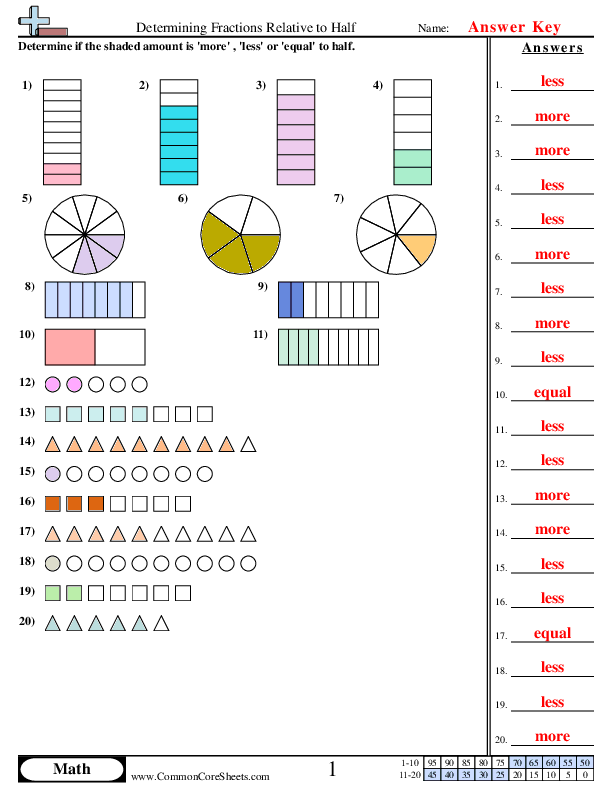
Determining Value Relative to Half
4nf2


×
Description:
"This worksheet is designed to educate children on the concept of fractions and their relation to half. Through 20 math problems, kids will enhance their numeracy skills and develop a better understanding of fractions. The worksheet can be customized according to individual learning needs, converted into flashcards for interactive study or used for distance learning, thereby offering a flexible, educational tool for children's mathematical development."

×
Student Goals:
Understanding Basics of FractionsAfter completing this worksheet, students should have a firm understanding of the basic principles of fractions, particularly in relation to halves. They will understand that a fraction represents a part of a whole and they will improve their ability to visualize this concept, enhancing their essential fraction comprehension. The exercises will improve their speed, efficiency, and accuracy in identifying and working with fractions.Comparing and Classifying FractionsThe worksheet will enable students to develop advanced skills in comparing and classifying fractions. Through their work with the problems, students will learn to differentiate between fractions that are more than, less than, or equal to half. This fundamental but important skill helps children appreciate the relative size of fractions, which is invaluable in advanced mathematical comprehension.Fraction Arithmetic SkillsAfter completing the worksheet, students should acquire hands-on practice in performing basic fractional arithmetic. Through the problems presented in the worksheet, students will fine-tune their ability to perform different mathematical operations with fractions, including addition, subtraction, multiplication, and division.Application of Fraction KnowledgeThe worksheet will also help students understand the applicability of fractions in real-life scenarios. After engaging with this worksheet, students will gain insight into how fractional knowledge can be transferred to everyday activities like cooking, shopping or sharing. Thus, making fractions less theoretical and more practical for students.Problem-Solving and Critical Thinking SkillsBy working on the problems in the worksheet, students will improve their problem-solving and critical thinking skills. Each problem will push them to think critically, strategize, and apply their fractional knowledge to find the best solution. These skills extend beyond mathematics, contributing to the overall intellectual development of the students.Foundation for Advanced MathematicsLast but not least, by mastering fractions in relation to halves, students will build a solid foundation for more advanced mathematical concepts. Fractions serve as a stepping stone to decimals, percentages, ratios, and algebra. With a firm grasp of fractional understanding, students will be well-equipped to tackle these advanced topics when they encounter them in higher grades.


Equivalent Fractions
Link
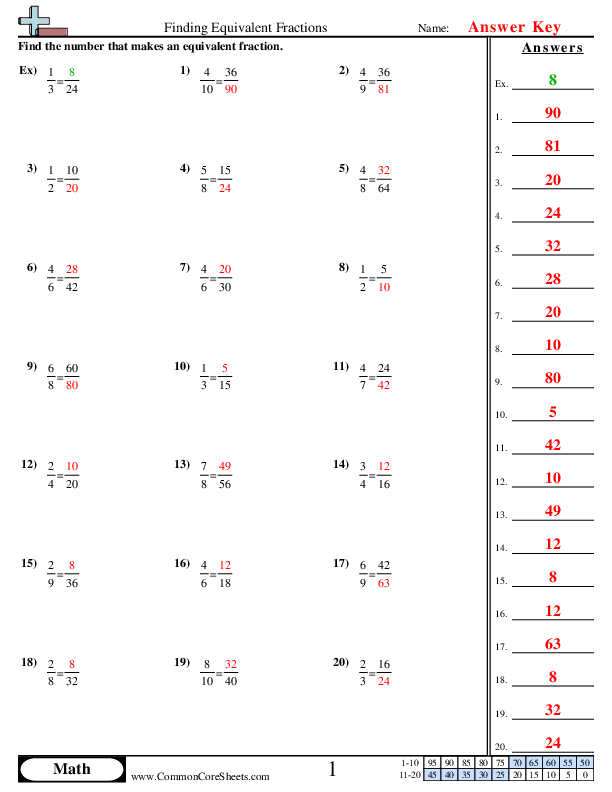
Equivalent Fractions (Missing Number)
4nf1


×
Description:
"This worksheet is designed to help children grasp the concept of equivalent fractions in math. It features 20 interactive problems, with examples such as 1/6 equals 2/12, 7/9 equals 28/36, and 3/6 equals 30/60. Perfect for distance learning, the worksheet can be customized for individual needs and even converted into flashcards to further facilitate understanding. Enhance your child's math skills through this engaging and adaptable tool."

×
Student Goals:
Understanding Equivalent FractionsAfter completing this worksheet, students should have a strong understanding of equivalent fractions. This fundamental concept in mathematics is critical as it underpins many more complex areas of study within the subject. By practicing to find equivalent fractions, students improve their problem-solving abilities and enhance their mathematical reasoning.Enhancing Calculation SkillsWorking through the worksheet will also help students to refine their calculation skills, especially their division and multiplication abilities. By repeatedly identifying equivalent fractions, students will become more fluent and confident in performing these calculations, helping them to improve their overall math competency.Improving Number SenseThe worksheet encourages the development of a strong number sense, which is the understanding of what numbers mean and their relationship to one another. By finding equivalent fractions, students will actively explore the relationships between numbers, leading to a deeper comprehension of mathematics.Developing Pattern RecognitionAs students work through the problems in the worksheet, they will also have opportunities to recognize and predict patterns. This is an important mathematical skill that will support them in diverse areas of study, such as algebra and geometry.Applying Mathematical ConceptsAt the completion of the worksheet, students will not only have bolstered their understanding of equivalent fractions but will also have enhanced their ability to apply this knowledge. Whether solving more complex mathematical problems or using these skills in real-world situations, they will be equipped with a crucial knowledge base, helping them excel in future learning endeavors.Building ConfidenceFinally, with each problem they successfully solve, students are building their confidence in solving mathematical problems. Overcoming challenges faced in this worksheet can foster perseverance and resilience, which are beneficial not just for math but for every aspect of their learning journey.


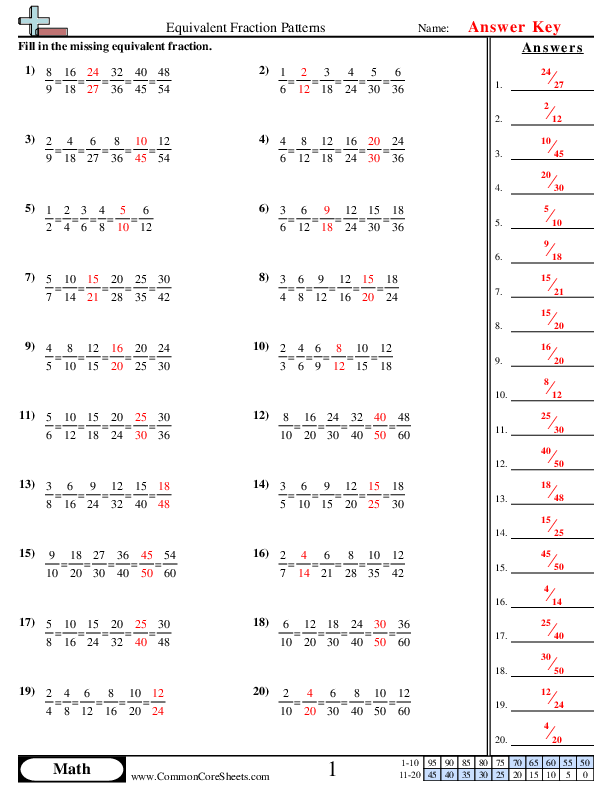
Filling in a pattern
4nf1


×
Description:
"This worksheet is designed to teach children about equivalent fractions through pattern recognition in math. It features 20 unique problems, where fraction equivalencies are visually represented in table format. The interactive nature of the content allows for customization, including the capacity to convert the worksheet into flash cards. This feature extends its usability, making it an excellent tool for distance learning and homeschooling environments."

×
Student Goals:
Understand Equivalent FractionsWith successful completion of this worksheet, students should develop a solid understanding of equivalent fractions. They should be able to recognize that different fractions can represent the same part of a whole, enhancing their numerical flexibility. This forms the basis for strong mathematical reasoning, feeding into other areas of number theory and arithmetic.Develop Problem-Solving SkillsThese carefully designed fraction problems should help students strengthen their problem-solving skills. By unraveling patterns and deducing the correct numerical value for each equivalent fraction, students exercise both inductive and deductive reasoning, preparing them for advanced math hurdles. This process refines their decision-making skills, teaching them to strategize and choose the most efficient route to a solution.Enhance Mental ArithmeticBeing repeatedly exposed to and working on these fraction problems will enhance students' mental arithmetic. They will be more comfortable and quicker at processing numbers mentally, which will be fruitful not just in mathematics, but across all subjects and day-to-day applications, increasing their number sense.Grasp Number PropertiesCompletion of this worksheet should aid students in grasping the properties of numbers, and how they interact in the context of fractions. They will have gained an understanding of the important mathematical concepts of ratio and proportion, thus extending their knowledge of numbers and paving the way for future mathematical learning.Application to Real-life SituationsThe learning attained from this worksheet extends beyond the classroom. It enables students to apply their knowledge to real-life situations. As fractions are ubiquitous in daily life scenarios, for instance, during cooking, shopping or time allocation in daily activities, comprehension of equivalent fractions can enhance practical problem-solving skills, empowering students to make accurate and efficient calculations.Builds a Foundation for Advanced MathUnderstanding fractions and equivalences, a subject matter of this worksheet, represents an essential mathematical concept that underlies more advanced topics. Successful completion will provide a solid foundation for future learning in fractions, decimals, pecentage calculations, algebra and even calculus. This core mathematical competency plays a crucial role in preparing students for advanced mathematical concepts and procedures.


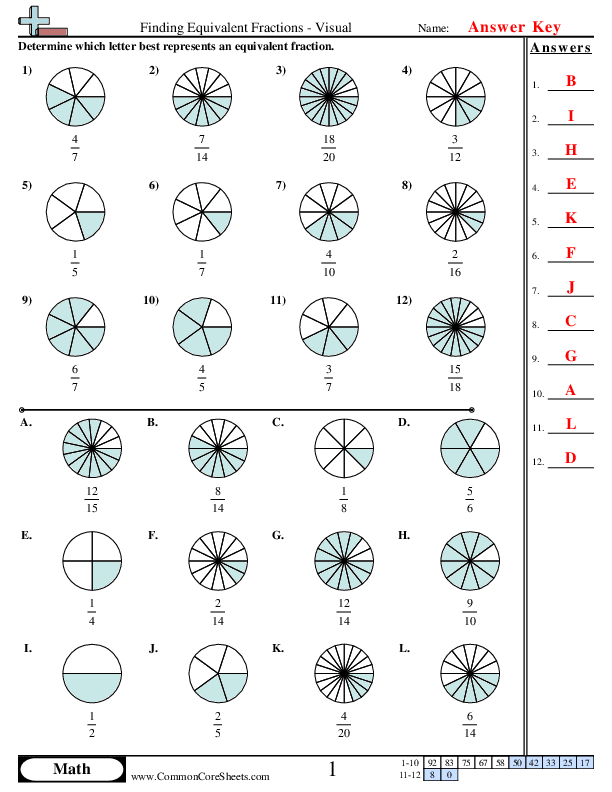
Finding Equivalent Fractions - Visual
4nf1


×
Description:
"This worksheet is designed to help children visually understand the concept of equivalent fractions in math. It provides 12 problems using vibrant diagrams to represent fractions and engage the student's interest. The flexible format allows it to be customized according to individual needs, converted into flashcards for easy review, or used in a distance learning setup to provide interactive math learning from home."

×
Student Goals:
Mastering Equivalent Fractions ConceptAfter successfully completing this worksheet, students should be able to confidently understand and demonstrate their knowledge of equivalent fractions. They will have gained much practice in finding equivalent fractions through visual aids which would significantly improve their skills. This worksheet is designed to aid them in visualizing what equivalent fractions look like, and how different fractions can represent the same value.Developing Problem-Solving AbilitiesSolving the problems presented in this worksheet would require students to engage their problem-solving skills. They will need to evaluate, analyze, and identify equivalent fractions. This worksheet will help enhance their cognitive development, fostering growth in analytical thinking and ability to recognize patterns. Over time, this will enhance the student's proficiency in working with other complex math problems.Boosting Confidence in MathMath can seem daunting to many students. However, having the ability to comfortably work through problems and see improvements serves as a confidence booster. As students find more success in dealing with these fraction problems, their confidence in their math skills is likely to increase. This, in turn, may foster a positive attitude towards learning and mastering other math topics.Application of Learned SkillsAfter completing the worksheet, students should be able to apply the skills they have learned to practical situations. The understanding of equivalent fractions can be used to simplify fractions or compare them. Moreover, they could apply these concepts when dealing with problems involving ratios, proportions, or probability, which they will encounter in more advanced math subjects.Fostering Self-Reliance and IndependenceThis worksheet is designed to promote self-reliance and independence. Students will find that they can work through the problems at their own pace, enhancing their ability to learn independently. This is a crucial lifelong learning skill that is applicable in many aspects of life beyond the classroom.


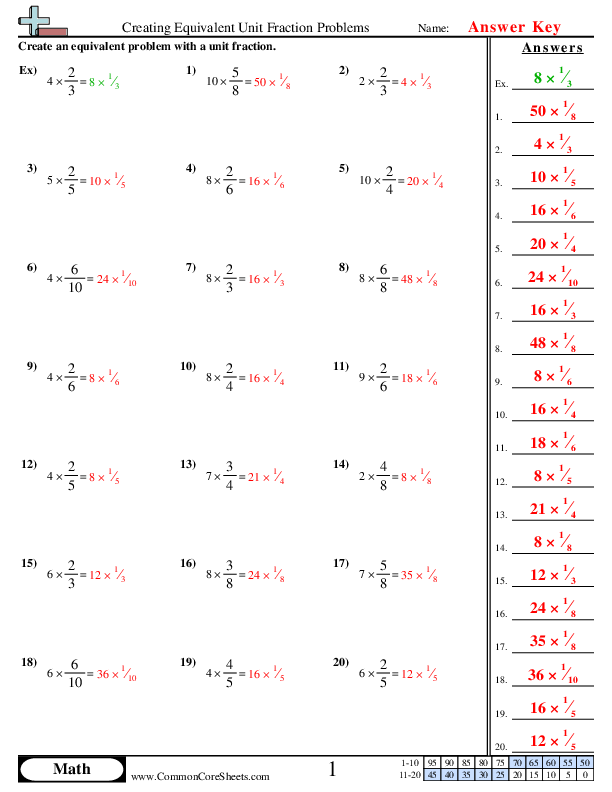
Creating Equivalent Unit Fraction Problems
4nf4b


×
Description:
"This worksheet is designed to enhance children's understanding of equivalent unit fractions in mathematics. It includes 20 problems, providing examples of multiplication with fractions to produce equivalent unit fractions. The dynamic and adaptable format allows it to be customized according to individual learning needs: it can be transformed into flashcards for easy revision or seamlessly integrated into distance learning modules. A practical and versatile tool for reinforcing key mathematical concepts."

×
Student Goals:
Understanding of Unit FractionsStudents will gain a solid understanding of unit fractions. They will be able to define what a unit fraction is and identify it when it is presented in a mathematical problem.Mathematical Operations with Unit FractionsAfter completing the worksheet, students would have practiced various mathematical operations involving unit fractions. They will be adept at multiplying whole numbers with unit fractions and simplify the results. They will also be proficient in expressing product of whole numbers and fractions as a product of a whole number and a unit fraction using properties of operations.Problem Solving SkillsThe worksheet will improve students' problem-solving skills, making them confident to tackle similar problems on their own. By applying their knowledge of unit fractions to a set of unique mathematical problems, they will develop the ability to implement appropriate solving strategies.Accuracy and PrecisionBy engaging with 20 unique unit fraction problems, students will improve their accuracy and precision in their mathematical work. The repetitive practice will enhance their ability to calculate correctly, minimizing any mistakes.Readiness for Advanced Math ConceptsUpon completion of the worksheet, students will be ready to take on more advanced mathematical concepts. The foundation built through understanding and applying unit fractions will be helpful in understanding more complex ideas such as higher-level fractions, decimals, ratios and percentages.Increased Mathematical ConfidenceOnce students have successfully solved all 20 problems, their confidence in their own mathematical abilities would have significantly improved. This confidence can encourage a positive attitude towards math, reducing any related anxiety and enhancing overall academic performance.


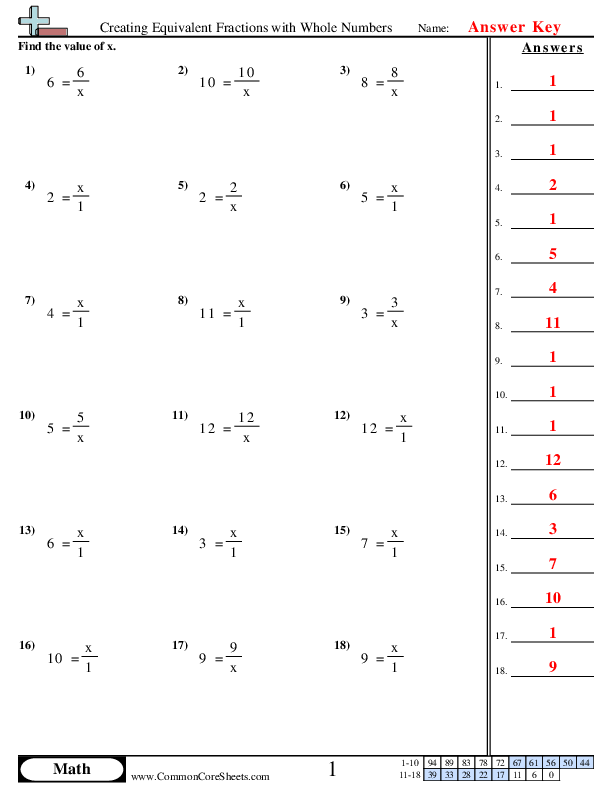
Comparing Fractions


×
Description:
"This worksheet is designed to teach children equivalent fractions using whole numbers. With 18 customizable math problems, students learn to identify proper fractions equivalent to given whole numbers. A valuable aid for distance learning, this versatile worksheet can also be converted into interactive flashcards, offering a flexible, engaging route to mastering essential math concepts."

×
Student Goals:
Understanding Equivalent FractionsUpon completion of this worksheet, students should have a solid understanding of equivalent fractions. They should be able to determine the equivalence of a whole number to a fraction by representing the whole number as the numerator and the denominator as 1. This exercise serves as a foundational learning tool for the concept of fractions as representations of whole numbers. It will provide them with tools needed for more complex fraction lessons in the future.Applying Mathematical ReasoningStudents should be able to apply their mathematical reasoning skills to solve problems accurately. They should be able to understand that whole numbers can be represented as fractions, and be able to calculate equivalent fractions. This demonstrates a knowledge of the fundamental properties of numbers and mathematical operations, formed through the practice of these worksheets.Learning Problem-Solving TechniquesAfter finishing the worksheet, learners should have gained valuable insight into techniques for solving fraction equivalencies. Methodically making sense of mathematical problems is vital in grasening the math concepts. These techniques will also be valuable when learners face more complex problems in future math lessons.Improving Computational SkillsThe worksheet should also aid in improving students' computational skills. By working through each problem, they can reinforce their knowledge of fundamental arithmetic principles. These skills are important not only in more advanced mathematics courses but also in daily life where fundamental arithmetic is commonly used.Promoting Logical ThinkingBy end of this worksheet, students should have improved their logical thinking skills, a tool vital for mathematical success. Understanding and applying the concept of equivalent fractions requires precise logical thought - an indispensable skill that goes beyond the classroom into daily decision-making scenarios.Reinforcing Consistent PracticeFinally, the conclusion of this worksheet should encourage students to understand the importance of consistent practice in mastering mathematical concepts. Tackling a good number of problems (18 in this worksheet) enables students to repeatedly apply new knowledge, invariably leading to better retention and understanding.


Converting Fractions
Link

Improper to Mixed Number
4nf3c


×
Description:
"This worksheet is designed to help children understand the conversion of improper fractions to mixed number fractions in math. With 20 customizable problems, it serves as a hands-on tool for instilling this key concept. As an added benefit, it can easily be converted into flashcards or incorporated into distance learning programs, making it a versatile educational resource."

×
Student Goals:
Understanding Improper Fractions and Mixed NumbersAfter successfully completing the worksheet, students should have a concrete understanding of improper fractions and mixed numbers. They should be able to differentiate between these two types of fractions and understand the relationship and conversion process between them. Students should be knowledgeable about the fact that an improper fraction is simply a fraction whose numerator is greater than the denominator, while a mixed number includes a whole number and a fraction combined.Fraction Conversion ProficiencyThe worksheet is designed to enhance proficiency in converting improper fractions to mixed numbers. This key skill is not only applicable in the realm of math but also plays a significant role in real-life scenarios such as measurements, cooking, and more. Understanding how to convert these numbers confidently is a fundamental skill in math, and this worksheet is an excellent tool for refining this ability.Problem Solving and Critical ThinkingBy solving the 20 problems in this worksheet, students should develop their problem-solving skills, increasing their ability to approach a math problem logically, work through potential solutions, and arrive at the correct answer. Critical thinking is a crucial element in math, and this exercise helps to address that while also reinforcing understanding of fractions.Solid Mathematical FoundationCompleting this worksheet contributes to a strong foundational understanding of fractions, which is vital in advancing to more complex mathematical concepts such as algebra and geometry. By mastering fractions, including improper fractions, and mixed numbers, students are setting the stage for future success in mathematics as these principles reappear in more advanced topics.Confidence BuildingThis comprehensive worksheet aids in building confidence in mathematics. As students successfully convert improper fractions to mixed numbers, their confidence in their mathematical abilities should increase. This confidence can then translate into overall academic success, as it inspires students to tackle other potentially challenging topics with a positive, can-do attitude.


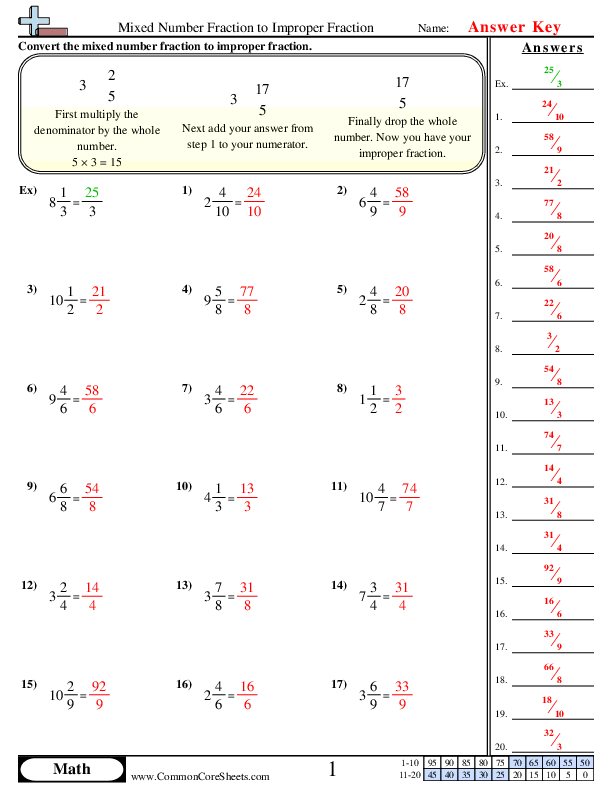
Mixed Number to Improper
4nf3c


×
Description:
"This worksheet is designed to strengthen children's math skills specifically in converting mixed number fractions to improper fractions. Containing 20 problems, the subject matter revolves around numeracy and mathematical understanding. The worksheet is fully customizable to suit individual learning needs and is versatile enough to be converted into flash cards or utilized for distance learning platforms, supporting various teaching and learning styles."

×
Student Goals:
Understanding of FractionsUpon completion of this worksheet, students should have a firm understanding of what fractions are, how they function, and how they are represented numerically. They should be able to easily identify and understand both mixed number fractions and improper fractions, recognizing the difference between these two types of fractions and understanding the contexts in which each might be used.Conversion SkillsStudents will develop their skills in converting between mixed number fractions and improper fractions. This includes learning how to convert complex mixed number fractions into simpler, more manageable improper fractions, thus simplifying their usage in further calculations. This skill is crucial for more advanced mathematical operations, as it enables students to work more easily with complex fractions.Problem-Solving AbilitiesWorking through the problems on this worksheet will enable students to strengthen their problem-solving abilities, enhancing their critical thinking skills and boosting their confidence in tackling mathematical problems. Confronted with 20 problems to solve, students would be improving their ability to handle mathematical challenges independently.Numeracy Skills EnhancementThe worksheet is designed to enhance the numeracy skills of the students, as they maneuver the conversion between mixed numbers and improper fractions. This will inevitably sharpen their basic arithmetic skills, as well as their ability to mentally calculate and estimate mathematical results.Preparation for Advanced ConceptsWorking on this worksheet should give students an excellent basis for tackling more advanced concepts in math. Being comfortable with fractions is a foundational aspect of many more advanced mathematical disciplines, meaning that this worksheet will contribute to the preparation of the students for future math topics. Converting between mixed numbers and improper fractions can be seen in algebra, trigonometry, and calculus, making it fundamental for mathematical advancement.Increased Math ConfidenceFinally, successfully completing this worksheet should give students a boost in their math confidence. Being able to understand and work with fractions is a key aspect of many areas of mathematics. Thus, good performance on this worksheet means they're making significant progress in their mathematical journey. This demonstrates their ability to understand and apply complex mathematical concepts, boosting their self-confidence and encouraging further study.


Comparing Fractions, Decimals & Percents
Link

Comparing Fractions (Numeric)
4nf6


×
Description:
"This worksheet is designed to reinforce children's understanding of comparing fractions. With a series of 20 customisable problems, it provides interactive numeric exercises to identify which fraction is greater or lesser. Ideal for distance learning, this dynamic tool can also be converted into flash cards, proving invaluable for mastering the vital math skill of fraction comparison."

×
Student Goals:
Understanding of FractionsAfter completing this worksheet, students should have a firm understanding of fractions. They will be able to identify numbers represented as fractions and interpret the value represented by each fraction. This is crucial because understanding of fractions is foundational in many mathematical and real-world contexts.Comparative SkillsStudents will develop their comparative skills by determining the relative value of two fractions. They will be adept at telling if a fraction is greater, less, or equal to another, aiding in decision making, problem-solving and cognitive development.Fraction NormalizationStudents will be able to normalize fractions to ensure they are in their simplest form. This will enhance students' fractions comprehension and provides a solid basis for advancing to more complex fraction problems.Mathematical ConfidenceAfter successfully completing the worksheet, students should be more confident in their mathematical abilities. Having gained some proficiency in one of the core concepts in mathematics, they would perceive math problems not as challenges but rather situations they can handle.Practical Mathematical ApplicationIt instills in students the realization that math can be applied practically to solve real-world problems. Comparing fractions is an essential skill in many situations including cooking, construction, and financial management.Numerical FluencyBy consistently practicing and resolving the problems, pupils will enhance their numerical fluency, or the ability to manipulate numbers and mathematical expressions comfortably. Increased numerical fluency leads to better comprehension of more advanced mathematical concepts.Enhancement of Cognitive AbilitiesThe process of comparing fractions requires a high level of cognitive function, including analysis and critical thinking. By working through the problems on this worksheet, students will enhance their cognitive abilities, which have widespread benefits across many aspects of life.


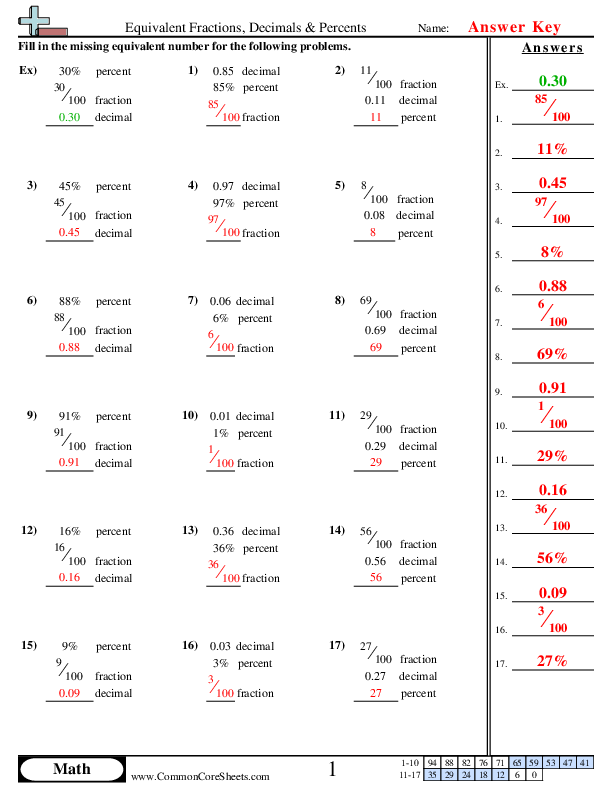
Fractions, Decimals & Percents (Numeric)
4nf6


×
Description:
"This worksheet is designed to aid in understanding the relation between fractions, decimals, and percentages. With 17 problems, it gives children hands-on practice in converting between these equivalent forms of numbers. Highly customizable, the worksheet can be adapted to fit different learners' needs, successfully converted into flashcards, or seamlessly integrated into distance learning curricula, providing an engaging tool to enhance math proficiency."

×
Student Goals:
Master the concept of equivalent fractions, decimals and percentagesAfter completing this worksheet, students should have a thorough understanding of the concept of equivalency among fractions, decimals, and percentages. They should be able to seamlessly convert a value from one form to another, showing a solid understanding of the integral relationships between these three mathematical representations.Develop computational skillsThis practice will foster students' computational skills, necessary for more advanced mathematical procedures. They would be well-versed with calculations involving the transition from fractions to decimals to percentages and vice-versa, enhancing their ability to calculate quickly and accurately.Promote problem-solving abilityBy working through the problems in this worksheet, students will improve their problem-solving skills. They will learn how to approach and solve complex problems involving fractions, decimals, and percentages. This practice will encourage critical thinking and logical reasoning, fundamental skills that are used in everyday life and other academic subjects.Amplify number senseCompletion of this worksheet will enhance students' number sense. It would promote a deeper understanding of the nature of numbers and their relationships, particularly in the context of fractions, percentages, and decimal values. This translates into improved mathematical intuition and a swift sense for number manipulation.Improve precision and attention to detailHandling fractions, decimals, and percents would help students fine-tune their precision and heighten their attentiveness to detail. As comprehension of these topics demands meticulous calculation and exactness, students will strengthen these qualities through consistent practice.Boost confidence in mathSuccessfully completing this worksheet means not only understanding the relationship between fractions, decimals, and percentages but also being adept at manipulating them. This mastery can result in greater confidence while facing math problems, which can in turn encourage a positive mindset towards learning new mathematical concepts.


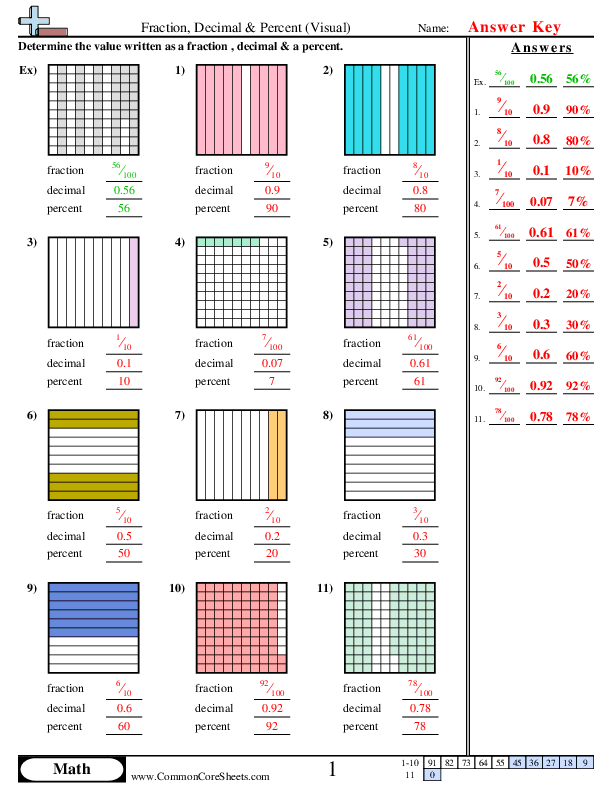
Fraction, Decimal and Percent (Visual)
4nf6


×
Description:
"This worksheet is designed to enhance children's understanding of the correlation between fractions, decimals, and percentages using clear visual aids. It offers 11 unique problems, enabling students to apply their learned concepts practically. Educators can customize this versatile resource, creating flashcards for a more interactive experience or integrating it into distance learning curricula. This focused approach aids in building a solid foundation for more complex mathematical concepts."

×
Student Goals:
Understanding of Basic Mathematical RepresentationStudents should demonstrate a solid grasp of basic mathematical representation by successfully completing each problem in the worksheet. This includes understanding fractions, decimals, and percentages, and their relations. They should be able to confidently convert fractions to decimals and percentages, and vice versa, thus displaying proficiency in manipulating different mathematical forms.Mathematical Literacy DevelopmentBy the completion of the worksheet, students should have improved their mathematical literacy. They're set to have deepened their understanding of mathematical concepts and terminology, especially those pertaining to fractions, decimals, and percentages. A boosted level of mathematical literacy will make them better at quickly recognizing and processing mathematical patterns, which is a key skill that will benefit them in future advanced mathematical endeavors.Analytical Skills EnhancementAfter engaging with the worksheet, students are expected to have enhanced their analytical skills. By navigating from fractions to decimals to percentages, and correlating their common value, students will have strengthened their analytical thinking. This is a critical skill not just in mathematics but in problem-solving in other academic spheres and real-life situations. It helps develop an independent thinking process that is essential to make them successful learners.Comprehension of Practical ApplicationsUpon completion, students are projected to appreciate the practical applications of what they have learnt. Fractions, decimals, and percentages are not just theoretical mathematical concepts; they come to life in many everyday scenarios. Whether it's managing personal finances, planning baking recipes, or analyzing sports statistics, these concepts are widely used. Understanding them can thus empower students to navigate their everyday life more effectively.Confidence in Mathematical AbilitiesFinally, students should gain enhanced confidence in their mathematical abilities. Successfully solving these exercises will give them a strong sense of achievement and boost their academic confidence. This belief in their own capabilities will motivate them to approach more challenging mathematical problems in the future with less fear and more determination. In learning, confidence is key, and through mastering this worksheet, students are setting up a positive foundation for all future learning.


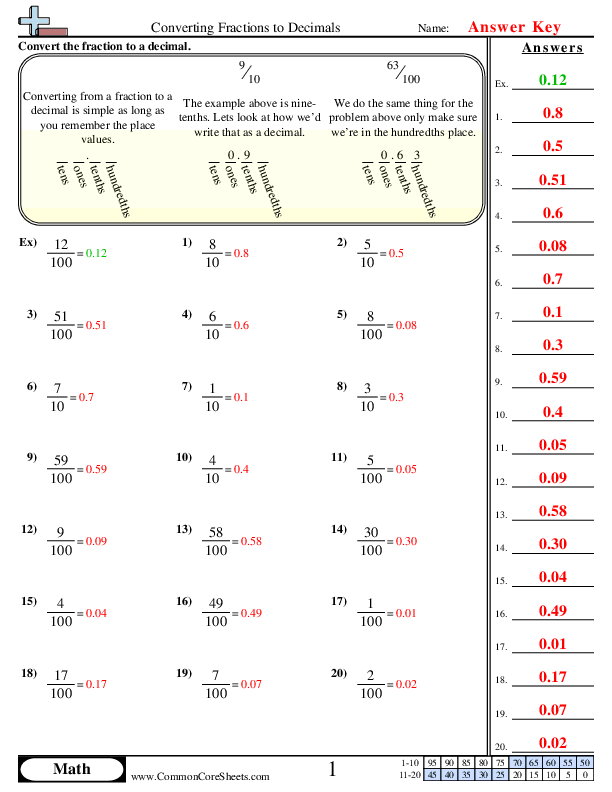
Converting Fractions to Decimals (10ths & 100ths)
4nf6


×
Description:
"This worksheet is designed to help children master the concept of converting fractions to decimals in a fun, engaging way. It offers 20 math problems where kids convert typical fractions into their decimal equivalents. Its interactive format offers adaptability and can be customized to suit individual learning needs. It could even be transformed into flash cards for additional practice or used in a distance learning environment to ensure continuous and effective learning."

×
Student Goals:
Understanding Fractions and DecimalsAfter completing the worksheet, students will have a clear understanding of how fractions and decimals are related. They will be able to effortlessly convert fractions to decimals and will know the underlying process behind it. This fundamental knowledge will allow them to navigate more complex math problems with ease.Mastery of Arithmetic SkillsBy practicing with twenty problems, students will achieve mastery in the arithmetic required to convert fractions into decimals. Their computation skills, coupled with an understanding of the place-value system used in decimals, will be significantly improved, enhancing their overall mathematical capabilities.Improved Problem-Solving SkillsThis worksheet is designed to foster mathematical inquiry, encouraging students to independently solve problems. After successful completion, they will have improved their problem-solving skills, which can be applied to other math topics and real-world scenarios.Boost in Mathematical ConfidenceBy successfully converting fractions to decimals, students will experience a significant boost in confidence, making them more likely to engage with mathematical topics in the future. This essential trust in their abilities can contribute positively to their overall academic performance.Preparation for Advanced Mathematical ConceptsThe knowledge of converting fractions to decimals is an integral part of more advanced mathematical concepts like algebra, percentage calculations, and data interpretation. Therefore, after completing the worksheet, students will be well-prepared for tackling these advanced topics when they encounter them.Enhancement of Analytical SkillsThe process of converting fractions to decimals involves step-by-step logical reasoning. As students navigate through these steps, they enhance their analytical skills — a trait that’s not only important in mathematics, but also beneficial in other subject areas and in everyday life.


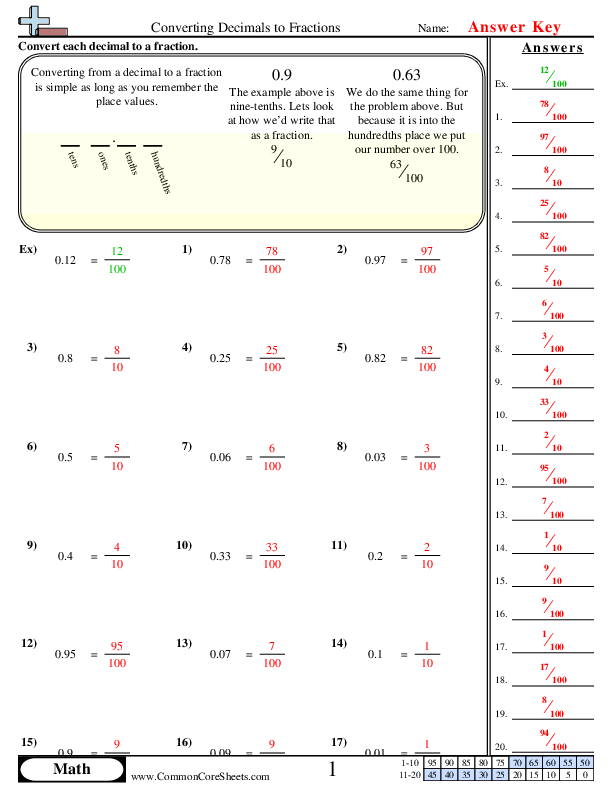
Converting Decimals to Fractions (10ths & 100ths)
4nf6


×
Description:
"This worksheet is designed to instruct students on the subject of mathematics, specifically converting decimals to fractions. With 20 problems that visualize decimal values equaling to fractions, it provides engaging examples and practical exercises. Flexible for any learning environment, this worksheet is customizable, can be effortlessly converted into flash cards, and is suitable for distance learning, making it an adaptable educational resource."

×
Student Goals:
Understanding of Decimals and FractionsAfter completing the worksheet, students will have a firm understanding of decimals and their corresponding fractions. They should grasp the important concept that fractions and decimals are just two different ways of expressing the same value. This understanding provides a strong foundation for more advanced mathematical concepts.Conversion SkillsThe completion of the worksheet will equip learners with the necessary skills to convert decimals into fractions effortlessly. They will understand the systematic process involved in transforming a decimal into both its reduced and non-reduced fraction forms. This skill is central to many aspects of mathematics and is crucial for subsequent learning stages.Enhanced Problem-Solving AbilitiesWorking through the problems on this worksheet requires logical reasoning and problem-solving skills. The students will be better at diagnosing the problem, understanding the steps it takes to solve it, and applying this approach to different, yet similar problems. These enhanced abilities extend well beyond mathematics and are beneficial to all other subjects.Confidence in MathematicsSuccessfully converting decimals to fractions can boost the confidence of the learners. Building assurance in their mathematical abilities will encourage them to tackle more challenging problems without fear of failure. This confidence is pivotal in stimulating a positive attitude towards mathematics and other numeracy-based subjects.Preparation for Advanced MaterialThe ability to convert decimals to fractions is important in higher mathematical contexts such as algebra, geometry, and calculus. By honing these skills now, students will be better prepared to manage future mathematical coursework. This worksheet sets the groundwork for these critical, more advanced mathematical concepts.Real-World ApplicationThe ability to convert decimals to fractions has many practical, real-world applications, including but not limited to understanding scientific data, making accurate financial decisions, or even dividing recipes in cooking. By mastering this skill, students will be able to handle numbers in various real-life situations more efficiently.



